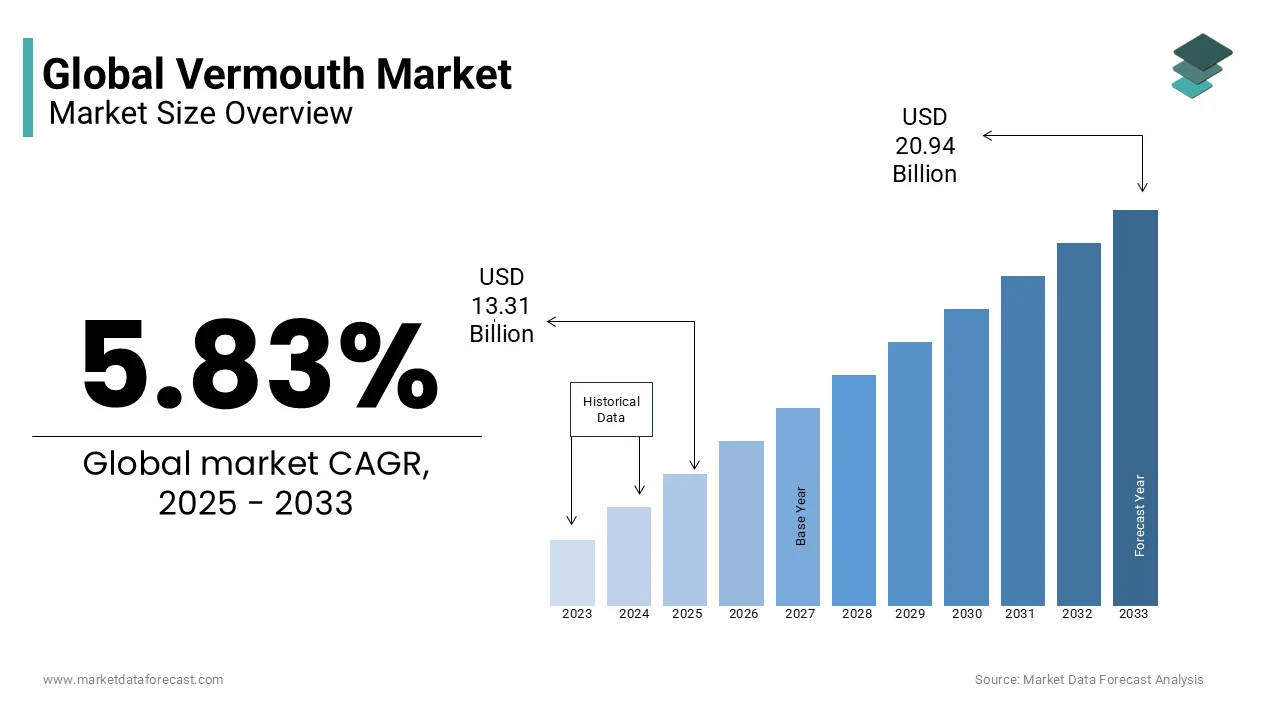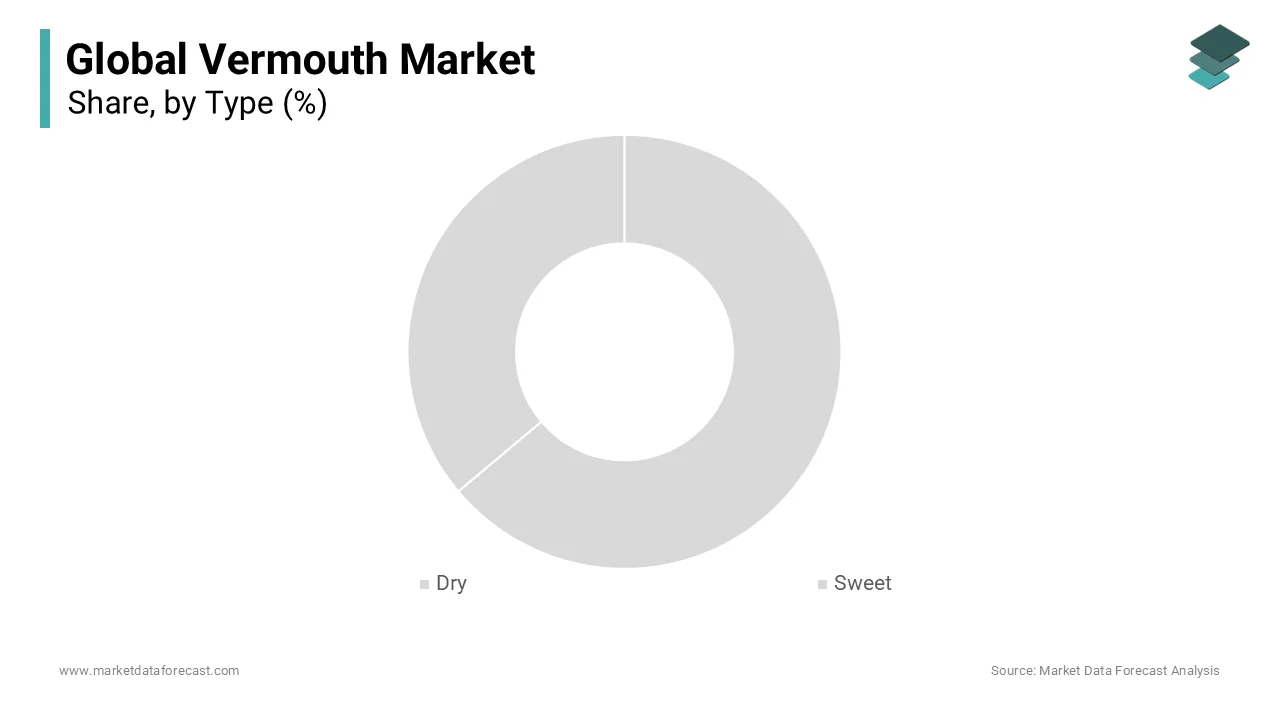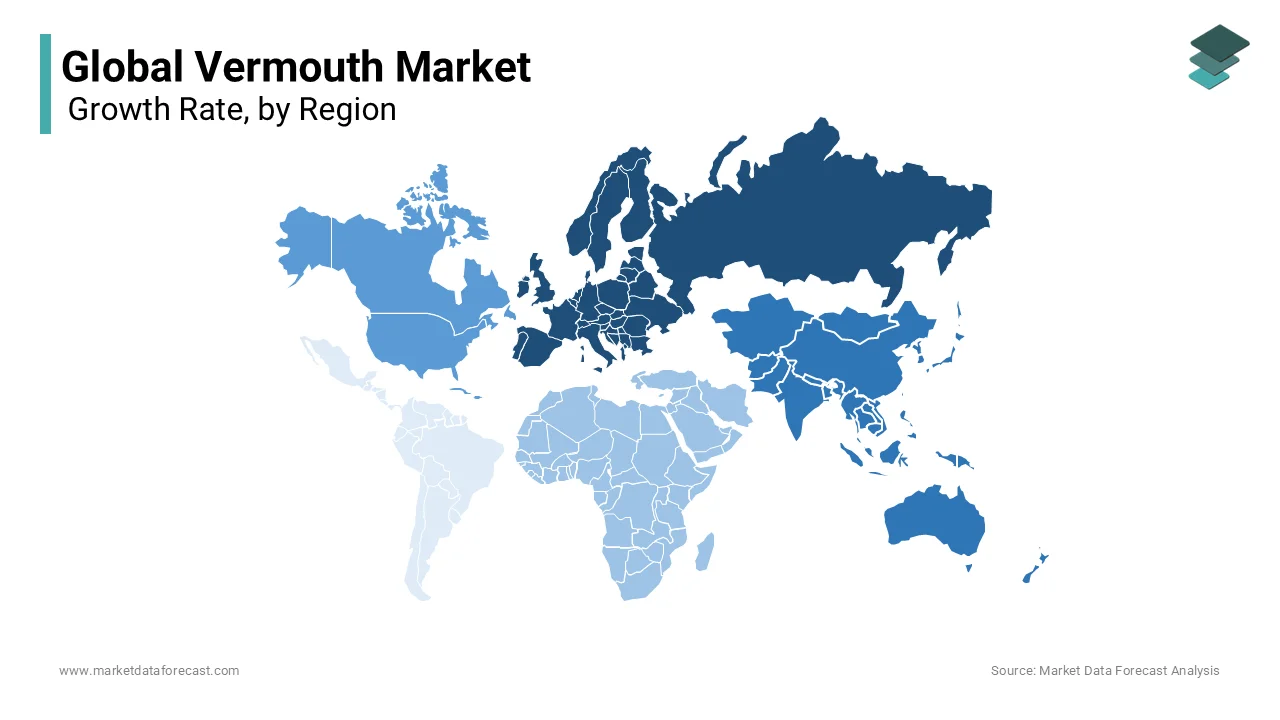Global Vermouth Market Size, Share, Trends & Growth Forecast Report - Segmented By Type (Dry and Sweet), Packaging, End-Use, Distribution Channel, and Region (North America, Europe, Asia Pacific, Latin America, And Middle East & Africa) - Industry Analysis (2025 To 2033)
Global Vermouth Market Size
The Global Vermouth Market size was valued at USD 12.58 billion in 2024, and the global market size is expected to reach USD 20.94 billion by 2033 from USD 13.31 billion in 2025. The market's promising CAGR for the predicted period is 5.83%.

Vermouth is an enriched white wine flavored with spices, roots, flowers, seeds and bark. Vermouth wines have a sweet taste and are the same as Martini and Cinzano. The manufacture of the product includes a reinforced base and herbal infusion. Vermouth wines are sweet aperitif wines, such as Sweet Cinzano or Martini. It is served with appetizing energy at 7-10 degrees Celsius before dinner. Vermouth contains 17 to 19% alcohol and 7 to 9% sugar. The elaboration of vermouth involves the elaboration of a suitable enriched base wine and the injection of spices. There are expanding the market size by continually expanding the generalization of fragrance-added mixed drinks with low liquor and low flavor. Vermouth is a type of wine enriched with a variety of plants such as bark, roots, seeds, herbs, flowers, and spices. It is usually consumed mainly before meals. Vermouth base wine is fortified with Mystelle. Mistelle is a mixture of unfermented grape juice and brandy in a ratio of one serving of brandy to four servings of grape juice. The dramatic increase in promotional activity is one of the key things that will support the growth of Vermouth's industry in the years to come.
MARKET DRIVERS
The growing demand for low-alcohol beverages among millennials and adults in pubs and restaurants is expected to be a key factor in the growth of the market The demand for new and exotic wines is constantly increasing and taste preferences rapidly change accordingly. For this reason, the main wine producers on the market are offering wines of various flavors to meet the needs of their customers. Additionally, the growing popularity of fortified and flavored wines among millennials around the world is expected to be a major market driver during the forecast period. Demand for these fortified alcoholic beverages is driven by a variety of consumption trends, including changing consumer preferences for traditional alcoholic beverages and improving economic indicators such as rising living standards and changes in lifestyle. The market is experiencing a great demand for Vermouth due to the constant increase in the income of the population, which is changing the way of life. These lifestyle changes are driving the growth of the Vermouth market. Rapidly evolving tastes and preferences have led to the emergence of exotic new flavors of Vermouth. Vermouth's market is strengthening due to growing demand for dry vermouth with a low sugar syrup content. Vermouth has a 75.0% wine content and is based on a variety of plants, including alcohol and roots, bark, herbs, flowers, spices, seeds, etc. to add aroma. These varieties of fortified wine are generally consumed before dinner throughout the world. In recent years, consumers have opted for alcoholic beverages such as cocktails of a wide variety rather than traditional alcoholic beverages such as gin and brandy. These cocktails are also popular with consumers before meals and are widely consumed in restaurants and hotels. These consumer trends are expected to promote the Vermouth range for years to come. Various traditional liquors, such as gin, are expected to face fierce competition as consumers prefer Vermouth over other beverages.
Spaniards consume wine every day to stimulate their appetite and aid in good digestion. Favorable trends in these consumer countries are determined to witness high market growth over the forecast period. Additionally, changes in customer taste and profitable demand for exotic product flavors will drive market demand. However, imposing high taxes on their products, along with strict laws governing the use of their products, hinders business growth. Additionally, the easy availability of product substitutes, coupled with the large intake of craft beer, will further hamper Vermouth's industry growth range. The growing demand for new fortified wine flavors is another growth engine for the global Vermouth market. Market players are creating new flavors for fortified wines to meet the changing needs of customers. Consumers' taste preferences are changing rapidly and there is a great demand for new and exotic flavors of fortified wines. Increased marketing and promotional activities, one of the key factors driving the growth of the market. In addition to this, increased demand for new flavors of improved wines based on consumer requirements, tastes, and preferences will create a lucrative roadmap for the Vermouth market in the near future.
MARKET RESTRAINTS
Huge tariffs and strict regulations set by government agencies on confiscated wines have the potential to slow market growth. Additionally, some customers prefer alcoholic beverages and craft beers over wine, which is also one of the main limiting factors.
REPORT COVERAGE
|
REPORT METRIC |
DETAILS |
|
Market Size Available |
2024 to 2033 |
|
Base Year |
2024 |
|
Forecast Period |
2025 to 2033 |
|
CAGR |
5.8% |
|
Segments Covered |
By Type, Distribution Channel, Application, And Region |
|
Various Analyses Covered |
Global, Regional and Country Level Analysis; Segment-Level Analysis; DROC; PESTLE Analysis; Porter’s Five Forces Analysis; Competitive Landscape; Analyst Overview of Investment Opportunities |
|
Regions Covered |
North America, Europe, APAC, Latin America, Middle East & Africa |
|
Market Leaders Profiled |
Violife Foods, Daiya Foods, Tyne Chease Limited, Vtopian Artisan Cheese Company, Kite Hill, Miyoko’s Kitchen Company, Vermont Farmstead Company, Good Planet Foods, Follow Your Heart, Galaxy Nutritional Foods, Inc. |
SEGMENTAL ANALYSIS
By Type Insights

The Vermouth market is divided into dry and sweet markets. The sweet segment dominated the market in 2024. Sweet vermouth, also known as red vermouth, is much sweeter than dry vermouth and typically contains 10-15% sugar. The dry segment is expected to register a high growth rate of 7.4% during the forecast period 2022 - 2027. Due to the low content of sugar syrup in this region, there is a growing demand for dry and additional dry vermouth.
By Distribution Channels Insights
On the basis of distribution channels, the Vermouth market is Segmented into direct and indirect. Indirect distribution channels are further subdivided into specialty stores, online retail stores, supermarkets and hypermarkets. Direct distribution channels occupy a larger market share in 2020. Major manufacturers have begun developing businesses in commerce with a focus on Vermouth. Additionally, as the nightlife trend of millennials and younger generations increases, the demand for Vermouth increases through in-trade distribution channels.
By Packaging Insights
In terms of packaging, the industry can be divided into plastic bottles and glass bottles. Of these segments, the glass bottle packaging segment is expected to make a significant contribution to overall market growth during the analysis schedule.
By End-Use Insights
Based on the end-use industry, the market is segmented into HoReCa, food industry, and beverage industry. Among end-use industry segments, the beverage end-use industry segment is likely to dominate overall market growth for the expected time.
REGIONAL ANALYSIS
Europe was Vermouth's largest market, with a share of more than 50% in 2024 due to significant consumption throughout the region. This product was first consumed in Italy and now France, Spain, and Italy are the largest Vermouth consumers in the world. Continental Europe is expected to make a significant contribution to the overall market size during the review period due to the large consumption of products in the region, coupled with large product exports to the continental United States.

Asia Pacific industry will see tremendous growth in the coming years, driven by consumer lifestyle changes, social media influences, and lounge and club entertainment trends accelerating sales of alcohol. Furthermore, the rapid urbanization and expansion of the middle-class population with increasing disposable income will further promote industrial growth in the Asia Pacific region. North America vermouth market is projected to grow faster, with an average annual growth rate of 8.2% from 2025 to 2033, as demand for dry vermouth with less sugar syrup increases. Additionally, fortified wines are gaining popularity among local consumers, mainly before meals.
KEY MARKET PLAYERS
Key Players In The Vermouth Market Anchor Distilling Company, Atsby Vermouth, Fratelli Branca Distillerie Srl (Carpano), Uncouth Vermouth, Belsazar, Giulio Cocchi Spumanti Srl, Cinzano, F.LLI Gancia & C. SpA-Canelli (Asti - Italy), Contratto, La Quintinye Vermouth Royal, Imbue, Lo-Fi Aperitifs, Martinez Lacuesta.
RECENT HAPPENINGS IN THE MARKET
In July 2019, El Bandarra, a brand famous for artisan vermouth, launched a new product in Barcelona, Spain, under the brand 'El Bandarra Vermut Rosé'.
MARKET SEGMENTATION
This research report on the global Vermouth Market has been segmented and sub-segmented based on Type, Packaging, End-Use, Distribution Channel & region.
By Type
- Dry
- Sweet
By Packaging
- Plastic Bottles
- Glass Bottles
By End-Use
- HoReCa
- Food Sector
- Beverage Sector
By Distribution Channel
- Direct
- Indirect
By Region
- North America
- Europe
- The Asia Pacific
- Latin America
- The Middle East and Africa
Frequently Asked Questions
1.What is vermouth?
Vermouth is a fortified wine flavored with various botanicals, herbs, spices, and sometimes caramelized sugar. It is typically enjoyed as an aperitif or used in cocktails.
2.How is vermouth made?
Vermouth is made by infusing a base wine with a blend of botanicals, which may include herbs, roots, barks, flowers, and spices. The wine is then fortified with a neutral spirit, usually brandy, to increase its alcohol content.
3.What are some popular vermouth brands?
Some popular vermouth brands include Martini & Rossi, Cinzano, Dolin, Carpano Antica Formula, Noilly Prat, and Cocchi.
Related Reports
Access the study in MULTIPLE FORMATS
Purchase options starting from $ 2500
Didn’t find what you’re looking for?
TALK TO OUR ANALYST TEAM
Need something within your budget?
NO WORRIES! WE GOT YOU COVERED!
Call us on: +1 888 702 9696 (U.S Toll Free)
Write to us: [email protected]